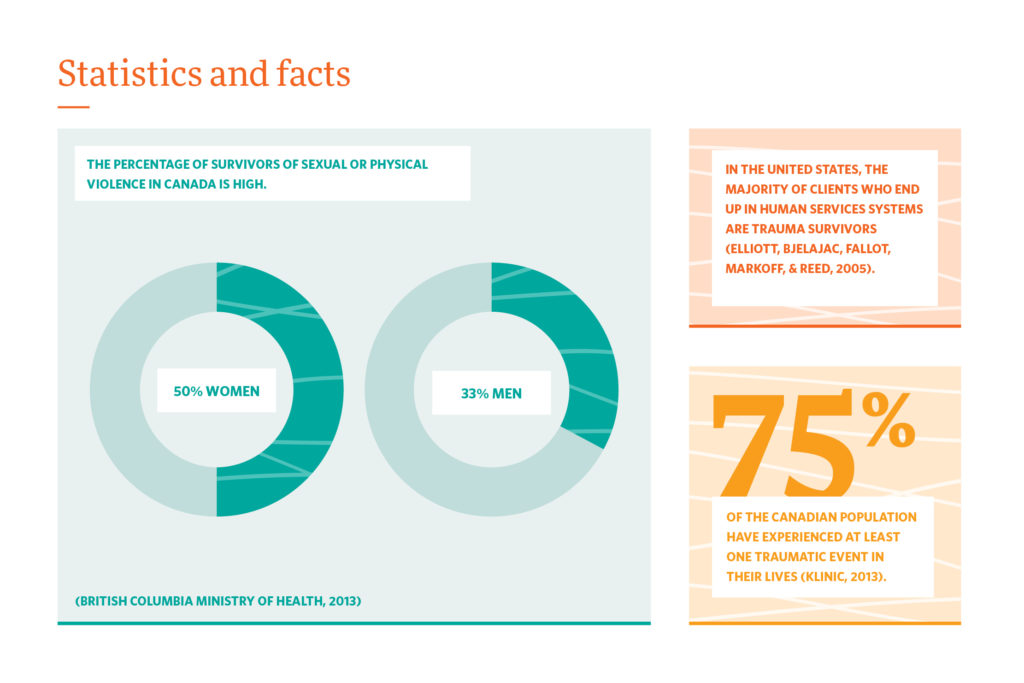This toolkit is one of a suite of three focused on trauma. The full suite includes: Trauma and suicide, Trauma and suicide in children and Trauma and suicide in Indigenous people.
Introduction
Trauma is very common among people in Canada.
Most people receiving treatment for mental health issues have had some form of trauma (Rosenberg, 2011). Trauma places us at a higher risk for mental health issues such as depression and addiction. People who have experienced trauma are also at a greater risk for suicide.

What is Trauma?
Trauma is “a horrific event beyond the scope of normal human experience” (Greenwald, 2007, p.7).
Some examples of traumatic experiences include:
- motor vehicle collision;
- rape;
- losing a loved one; and
- childhood abuse or neglect.
Some effects of trauma are:
- alcoholism;
- depression;
- insomnia;
- suicide attempts; and
- relationship problems.
(Centre for Addictions and Mental Health, 2012)
Symptoms of trauma include:
- disconnection from self;
- emotional numbing (including drinking alcohol and doing drugs);
- eeduced awareness or hyper-awareness of surroundings;
- memories, flashbacks, and/or nightmares of the traumatic event;
- blame of self or others;
- loss of interest in former activities;
- aggressive or risk-taking behaviours; and/or
- change in sleeping habits.
(American Psychiatric Association (APA), 2013)
Disorders associated with trauma
Acute Stress Disorder (ASD) may be an individual’s initial reaction to a traumatic event. If trauma symptoms (noted above) go on for more than one month, that individual should be assessed for Post Traumatic Stress Disorder (PTSD).
Symptoms of ASD and PTSD may trigger other disorders such as substance use, anxiety, mood, personality, and eating disorders (Halpern, Maunder, Schwartz & Gurevich, 2011; APA, 2013).
When a traumatized individual has one or more disorder they are at higher risk for suicide.
Who is at risk?
Everyone is at risk of trauma, especially:
- people with poor/deteriorating health;
- people receiving ongoing medical treatment (e.g. cancer and psychiatric patients);
- homeless people;
- Indigenous people;
- children who have suffered neglect;
- refugees;
- first responders (e.g. police, fire fighters, paramedics);
- military personnel and veterans; and
- medical doctors.
What is Trauma-Informed Care?
Health care professionals are more aware of the effects of trauma than ever, and this has led to the creation of Trauma-Informed Care (TIC) — a determined effort to implement a better approach to treating patients that takes into account the impact that previous traumatic experiences have had on an individual’s overall mental health. TIC represents a significant paradigm shift from what has been called a “deficit perspective” to one that is strengths-based (British Columbia Ministry of Health, 2013).
“What is wrong with you?” has shifted to “What has happened to you?” (Rosenberg, 2011).
Trauma-Informed Care (TIC) can be adopted by anywhere in the “behavioural health system” including:
- emergency rooms;
- doctors’ offices;
- rehabilitation centres;
- transitional housing centres; and
- counselling offices.
Being trauma-informed means:
- understanding the prevalence of trauma and its impact;
- recognizing the signs and symptoms of traumatization;
- creating an emotionally and physically safe space, and empowering the individual with an active voice in collaborative decision-making; and
- respecting the person’s experience through active listening, being sensitive to the language used, being transparent, being trustworthy, and offering stability and consistency.
(Bath, 2008; Hodas, 2006; Rosenberg, 2011; SAMHSA, 2015; Huckshorn & LeBel, 2013).
Read more about TIC in iE13: Trauma Informed Care: Trauma, Substance abuse and Suicide Prevention
Trauma-Informed Interventions and Therapies
Psychological First Aid
Psychological First Aid is an evidence-informed approach for assisting children, adolescents, adults, and families in the aftermath of disaster and terrorism.
Critical Incident Stress Debriefing (CISD) is a “7-phase, small group supportive crisis intervention process” (Mitchell, n.d., p.1).
Cognitive Behavioural Therapy (CBT) is a short-term, goal-oriented psychotherapy treatment that takes a hands-on, practical approach to problem-solving.
Exposure Therapy is an approach that allows the patient to confront their traumatic memories either all at once or gradually.
Eye Movement Desensitization Reprocessing (EMDR) is an evidence-based psychotherapy for PTSD which aims to reorient and repair the patient’s inability to process traumatic experiences.
Narrative Therapy is a psychotherapeutic approach which allows people to re-tell and re-interpret their personal stories and gives them an opportunity to construct alternative possibilities to their individual narratives.
Stress Inoculation Training (SIT) is a psychotherapy method intended to help patients prepare themselves in advance to handle stressful events successfully and with a minimum of upset (SAMHSA, 2014).
References
American Psychiatric Association. (2013). Diagnostic and statistical manual of mental disorders, DSM-5 (5th ed.). Washington, DC: American Psychiatric Publishing.
Bath, H. (2008). The three pillars of trauma-informed care. Reclaiming Children and Youth, 17(3),17-21.
British Columbia Ministry of Health. (2013). Trauma-Informed Practice Guide. Retrieved from http://bccewh.bc.ca/wp-content/uploads/2012/05/2013_TIP-Guide.pdf
Centre for Addictions and Mental Health. (2012). Trauma: What is trauma? Retrieved from http://www.camh.ca/en/hospital/health_information/a_z_mental_health_and_addiction_information/Trama/Pages/default.aspx
Elliott, D., Bjelajac, P., Fallot, R., Markoff, L., & Reed, B. (2005). Trauma-informed or trauma-denied: Principles and implementation of trauma-informed services for women. Journal of Community Psychology, 33(4), 461-477.
Greenwald, R. (2007). EMDR: Within a phase model of trauma-informed treatment. New York: Routledge.
Halpern, J., Maunder, R., Schwartz, B., & Gurevich, M. (2011). Identifying risk of emotional sequelae after critical incidents. Emergency Medicine Journal. Retrieved from http://emj.bmj.com/content/early/2010/05/29/emj.2009.082982.short
Hodas, G. (2006). Responding to childhood trauma: The promise and practice of trauma informed care. Retrieved from http://www.childrescuebill.org/VictimsOfAbuse/RespondingHodas.pdf
Huckshorn, K. & LeBel, J. (2013). Trauma-informed care. In Yeager, K., Cutler, D., Svendsen, D., & Sills, G. (Eds.), Modern community mental health: An interdisciplinary approach (p.62-83). Oxford, UK: Oxford University Press.
Klinic Community Health. (2013). Trauma-informed: The trauma toolkit. Retrieved from http://www.klinic.mb.ca/docs/PostersAndBrochures/Klinic%20Trauma%20-%20a%20normal%20reaction%20Broch.pdf
Mitchell, J. (n.d.). Critical Incident Stress Debriefing. Retrieved from http://www.info-trauma.org/flash/media-e/mitchellCriticalIncidentStressDebriefing.pdf
Olson, R. (2013). infoExchange 13: Trauma informed care. Retrieved from https://www.suicideinfo.ca/LinkClick.aspx?fileticket=6UAobvbsp7Y%3d&tabid=625
Rosenberg, L. (2011). Addressing trauma in mental health and substance use treatment. The Journal of Behavioral Health Services & Research, 38(4), 428-431.
Substance Abuse and Mental Health Services Administration (SAMHSA). (2014). Trauma-informed care in behavioral health services: A treatment improvement protocol. Rockville, MD: U.S. Department of Health and Human Services.
